VNAV OPERATION
Automatic vertical navigation is provided using the FMC and the AFDS VNAV function.
自動垂直ナビゲーションは FMC と AFDS VNAV 機能により使用され供給されます
When the AFDS is engaged in the VNAV mode, the FMC controls altitude and speed.
AFDS が VNAV モードにエンゲージされている時、FMC は高度とスピードをコントロールします
Altitude control is coordinated with the AFDS MCP selected altitude.
高度コントロールは AFDS MCP で選択された高度でコーディネートされます
Speed control can be managed via the FMC or by using speed intervention on the AFDS panel.
スピードコントロールは FMC または AFDS パネル上のスピード介入を使用することを介して操縦することができます
VNAV has two modes of operation: VNAV Speed (VNAV SPD) and VNAV PATH (VNAV PTH).
VNAV は 2 つのモードがあります:VNAV スピード ( VNAV SPD ) と VNAV PATH ( VNAV PTH )
VNAV SPD mode is used primarily for climbing and provides for a full power climb to programmed altitude.
VNAV SPD モードは上昇のために主として使用され、プログラムされた高度までフルパワーで上昇のために提供されます
VNAV PTH mode is used during cruise and descent.
VNAV PTH モードは巡航と降下のあいだ、使用されます
The FMC calculates a descent path based on LEGS page altitude inputs for the AFDS to follow while in VNAV PTH mode.
FMC は降下パスを LEGS ページの VNAV PTH モードでの AFDS のための高度入力を基本として計算します
If the plane is off path, the AFDS reverts to VNAV SPD mode to catch the path.
もし飛行機がパスを通りすぎたら、AFDS はパスを捉えるため VNAV SPD モードに復帰します
More information on this can be found in the VNAV descent explanation.
これについての更なる情報は VNAV 降下説明で見つけることができます
FMC speed and altitude programming are accomplished using the VNAV and LEGS pages.
FMC のスピードと高度のプログラミングは VNAV と LEGS ページを使用することで完了します
The VNAV pages are found by pressing the VNAV key on the FMC keyboard.
VNAV ページは FMC キーボードの VNAV キーを押すことにより見つかります
Each VNAV page is described below.
それぞれの VNAV ページについて以下に説明します
The LEGS pages are found using the LEGS key and have been described previously.
LEGS ページは LEGS キーを使うことにより見つかり、以前に説明した通りです
The LEGS page lists speed and altitude data for each waypoint along the right side of the page abeam each waypoint.
LEGS ページはそれぞれのウェイポイントのスピードと高度データを画面の右側のそれぞれのウェイポイントの横にリスト表示します
There are three pages of VNAV data that correspond to climb, cruise and descent.
上昇、巡航、降下に相当する VNAV データの 3 つのページがあります
Depending on the phase of flight, pressing the VNAV key displays one of these three pages.
フライトのフェーズにより、VNAV キーを押すとこれらの 3 つのページのうちのひとつが表示されます
Each page can be subsequently displayed by pressing the NEXT or PREV PAGE key on the FMC keyboard.
それぞれのページはその後、FMC キーボードの NEXT または PREV PAGE キーを押すことにより表示できます
Speed and altitude data on all FMC pages is displayed using either small or large fonts.
全ての FMC ページのスピードと高度データは小さい文字か大きい文字のどちらかで表示されます
Small fonts represent FMC “predicted” speeds and altitudes.
小さい文字は FMC による "predicted" ( 予測 ) スピードと高度を表します
Large fonts represent speed and altitude “restrictions” manually entered by the pilot.
大きい文字はスピードと高度の "restrictions" ( 制限 ) をパイロットがマニュアルで入力したことを表します
The differences between these two will become obvious during our discussion here.
これらの 2 つの間の違いは、ここで説明して明らかにします
If no speed or altitude prediction/restriction exists for a waypoint, the FMC will display “----“ in the data box.
もしウェイポイントにスピードまたは高度の予測/制限が存在しない場合は FMC はデータブロックに "----" を表示します
VNAV Altitude Programming
Lets first discuss an overview of how altitudes are handled by the FMC and displayed on the VNAV and LEGS pages.
最初に高度制御の方法の概要は FMC による受け渡しと、VNAV と LEGS ページの表示について説明しましょう
Then we will discuss how to use this information for VNAV operation.
それから VNAV 操縦のためにこの情報をどう使うかを説明します
Altitudes programmed into the FMC become VNAV target altitudes and are handled differently depending on the current phase of flight.
FMC への高度のプログラムはターゲット高度を VNAV にし、フライトの現在のフェーズにより違う受け渡しが行われます
Based on the CRZ ALT entered by the pilot on the PERF INIT pages during preflight, the FMC calculates a “top of climb” (or T/C) point.
パイロットがプリフライトの時 PERF INIT ページにより CRZ ALT を基本にしての入力により FMC は "top of climb" ( または T/C ) ポイントを計算します
Prior to the calculated T/C point, the aircraft is considered to be in the climb phase.
計算された T/C ポイントより前は、飛行機は上昇フェーズとみなされます
064
After the T/C point is reached, the aircraft is considered to be in the cruise phase.
T/C ポイントに到着後、飛行機はクルーズフェーズとみなされます
The FMC also calculates a “top of descent” (or T/D) point based on altitude restrictions entered by the pilot for the arrival waypoints in the LEGS page.
FMC はパイロットによる LEGS ページでのアライバルウェイポイントの制限高度の入力を元に "top of descent" ( または T/D ) ポイントも計算します
After passing the calculated T/D point, the aircraft is considered to be in the descent phase.
計算された T/D ポイントを通過後、飛行機は降下フェーズとみなされます
The VNAV target altitude differs depending on if the aircraft is in the climb phase, cruise phase, or descent phase.
VNAV ターゲット高度は飛行機が上昇フェーズの時、クルーズフェーズの時、降下フェーズの時により異なります
When VNAV is engaged, the AFDS continually compares the VNAV target altitudes with the AFDS selected MCP altitude.
VNAV がエンゲージされている時、AFDS は VNAV ターゲット高度を AFDS が MCP 高度で選択された高度と逐次比較しています
It then commands the aircraft’s vertical navigation based on that comparison.
飛行機の垂直ナビゲーションに比較を元にしてコマンドを出します
The VNAV target altitude during the climb phase is the lowest of the AFDS MCP altitude, the manually entered LEGS page altitude restrictions, or the FMC CRZ ALT.
上昇フェーズ中の VNAV ターゲット高度は AFDS MCP 高度の最低高度で、LEGS ページにマニュアルで入力した制限高度、または FMC CRZ ALT です
During the cruise phase, the VNAV target altitude is the manually entered FMC CRZ ALT.
クルーズフェーズ中は、VNAV ターゲット高度はマニュアルの FMC CRZ ALT 入力です
Altitude changes during the cruise phase are coordinated between the FMC CRZ ALT and the AFDS MCP altitude.
クルーズフェーズ中の高度変更は FMC CRZ ALT と AFDS MCP 高度との間でコーディネートされます
In the descent phase, the VNAV target altitude is the highest of the AFDS MCP altitude, or the manually entered LEGS page altitude restrictions.
降下フェーズ中は、VNAV ターゲット高度は AFDS MCP 高度の最高高度、または LEGS ページでのマニュアルでの高度制限入力です
During a VNAV climb or descent, if the AFDS MCP altitude is reached prior to the VNAV target altitude, the AFDS exits VNAV mode and enters ALT HOLD mode.
上昇または降下中の VNAV は、もし AFDS MCP 高度が VNAV ターゲット高度の前に到着したら、AFDS は VNAV モードを終了し、ALT HOLD モードに入ります
If the VNAV target altitude and the MCP altitude are the same, the AFDS will remain in VNAV mode.
もし VNAV ターゲット高度と MCP 高度がいっしょならば、AFDS は VNAV モードを残します
Examples of how this works are provided later in this section.
この働きの例として、このセクションの後で説明します
The FMC displays altitude data for each waypoint in the route on the LEGS page.
FMC は LEGS ページのルート内のそれぞれのウェイポイントの高度データを表示します
The FMC displays altitudes as either the actual altitude or as a “Flight Level”.
FMC は現在の高度または "Flight Level" ( フライトレベル ) のどちらかで表示します
The VNAV CLB page (described later) has an entry for “transition level”.
VNAV CLB ページ ( 後で説明します ) は "transition level" ( トランジッションレベル ) のための入力を持ちます
All altitudes above the transition level are displayed as flight levels.
トランジッションレベルの上の全ての高度はフライトレベルで表示されます
Flight level altitudes are abbreviated into 3 digits with “FL” prior to the altitude.
フライトレベル高度は高度の前に "FL" を付け、数字を 3 桁に短縮して使用します
For example, 33000 feet is abbreviated as FL330 in the FMC.
たとえば 33000 フィートならば FMC には FL330 となります
Valid manual entries for altitudes are as follows: 33000, FL330, 330.
高度のための有効なマニュアルの入力は次のようです:33000, FL330, 330
Entry of one of these values into a data block tells the FMC that you are entering 33000 feet.
データブロックにこれらの値のどれでもひとつを入力すると FMC には 33000 フィートとして入力されます
For lower altitudes such as 8000 feet, valid entries are as follows: 8000, FL080, 080.
8000 フィートの高度以下のために、値の入力は次のようです:8000, FL080, 080
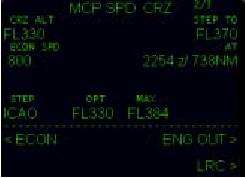
During FMC pre-flight preparations, a cruise altitude is programmed into the CRZ ALT boxes of the PERF INIT page.
FMC のプリフライトプリパレーション ( 準備、予習 ) 中、クルーズ高度は PERF INIT ページの CRZ ALT ボックスにプログラムされます
This CRZ altitude is transferred over to the VNAV pages for altitude calculations.
この CRZ 高度は高度計算のために VNAV ページに送られます
The picture at right shows the VNAV cruise page.
右の絵では VNAV クルーズページが見えています
Notice that the CRZ ALT (1L data block) is displayed as FL330.
CRZ ALT ( 1L データブロック ) は FL330 と表示されていることに注意してください
This indicates that the planned cruising altitude for this flight is 33000 feet.
これはこのフライトのクルージング高度は 33000 フィートにプランされていることを示しています
065
The FMC has a feature called “step climb”.
FMC は "step climb" ( ステップクライム ) と呼ぶ特徴を持っています
The FMC continually calculates the optimum cruise altitude based on aircraft performance data.
FMC は飛行機のパフォーマンスデータを元に最適のクルーズ高度を計算し続けます
In the picture above, the 1R data block shows a “STEP TO” altitude of FL370 along with a distance prediction below it.
上の絵で、1R データブロックに "STEP TO" と表示され、FL370 の高度とそれまでの予想距離が見えます
This indicates that the FMC has calculated that for optimum performance, a climb to 37000 feet approximately 738NM after departure should be executed.
これは FMC が最適のパフォーマンスで計算した値を示します。ここから実行を開始するとおおよそ 738NM で 37000 フィートに上昇します
On the LEGS page, the manually programmed CRZ ALT should be listed as altitude predictions for all waypoints prior to the calculated step climb point.
LEGS ページ上で、マニュアルでの CRZ ALT のプログラミングすると、ステップクライムポイントの計算の前に全てのウェイポイントのための予想の高度をリスト表示します
The altitude listed in the “STEP TO” box becomes the predicted altitudes for all waypoints after the step climb point.
"STEP TO" ボックスの高度のリスト表示はステップクライムポイントの後の全てのウェイポイントのための予想高度になります
For example, even though the programmed CRZ ALT is 33000 feet, the LEGS pages will list 37000 feet for all waypoints after the step climb point.
たとえば、プログラムされた CRZ ALT が 33000 フィートで、LEGS ページはステップクライムポイントの後の全てのウェイポイントのための 37000 フィートをリスト表示します
This is made clear in the explanation below.
これは下の説明で明らかにします
The size of the step climb can be adjusted on the VNAV CRZ page by using the “STEP” box abeam the 5L LSK.
ステップクライムのサイズは 5L LSK の横の "STEP" ボックスを使うことにより、VNAV CRZ ページ上で調整することができます
The word “ICAO” in this block indicates that the FMC is using standard ICAO flight levels for step climb calculations.
このブロックの "ICAO" は FMC がステップクライムの計算のために標準の ICAO フライトレベルを使用していることを示しています
When the word ICAO is shown in this data box, the FMC transfers to the LEGS page the FMC calculated optimum altitude regardless of CRZ ALT programmed.
ICAO がこのデータブロックに入っている時は、FMC は LEGS ページに FMC が CRZ ALT のプログラムされた高度に関係無く最適の高度を計算で出し、これを送ります
This means that if 33000 feet is programmed as a cruise altitude, but the FMC has calculated that 37000 is optimum, the LEGS page will list FL370 as the predicted altitude for each waypoint after the step climb point.
この意味は、もし 33000 フィートがクルーズ高度としてプログラムされていても、しかし FMC は 37000 での快適な計算を行い、LEGS ページはステップクライムポイントの後のそれぞれのウェイポイントのための FL370 への予想高度をリスト表示します
To prevent the FMC from transferring the step climb altitudes to the LEGS pages, enter a “0” into the STEP data block.
FMC が LEGS ページへのステップクライム高度の送信から防ぐため、STEP データブロックに "0" を入力します
The FMC still calculates the step climb points, but they will not be transferred to the LEGS page.
FMC はそれでもステップクライムポイントを計算します。しかしそれらは LEGS ページには送られません
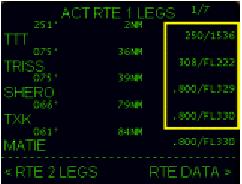
The picture at right shows the LEGS page for our example flight from KDFW to KLGA.
右の絵の LEGS ページに見えるように、ここでの例では KDFW 空港から KLGA 空港へのフライトです
Speeds and altitudes are listed abeam each waypoint on the right side of the page.
スピードと高度はページの右側のそれぞれのウェイポイントの横にリスト表示されます
The format is “speed/altitude”.
フォーマットは "speed/altitude" スピード/高度です
The data is displayed in small fonts indicating that these are predicted values.
データは小さい文字で表示されており、これらは予想されている値を示します
The FMC is predicting that the aircraft will cross each waypoint after departure at the listed speed and altitude.
FMC は飛行機が出発した後、リスト表示されているスピードと高度でそれぞれのウェイポイントを通過することを予想しています
The FMC predicts a “top of climb” (T/C) point based on aircraft performance.
FMC は飛行機のパフォーマンスを元に "top of climb" ( T/C ) ポイントを予想します
The top of climb is the point where the FMC predicts the aircraft will level off at the FMC programmed CRZ altitude.
上昇終了点は FMC が予想した、飛行機が FMC にプログラムした CRZ 高度でレベルオフするであろうポイントです
This T/C point is displayed on the EHSI along the route with a green circle labeled “T/C”.
この T/C ポイントは EHSI 上にグリーンの円で "T/C" とラベルがつけられルートに沿って表示されます
Notice that TXK is the first waypoint with FL330 as the predicted altitude.
TXK は予想した高度の FL330 の最初のウェイポイントであることに注意してください
All other waypoints have a lower altitude prediction displayed because they are prior to the top of climb point.
その他の全てのウェイポイントは、低高度で予想されています。なぜならばそれらは上昇終了点の前だからです
066
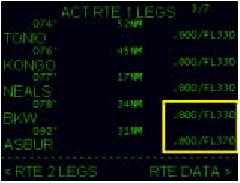
Looking at waypoints further along in the route, the predicted altitudes have changed to FL370.
ルートに沿ってもっと遠くのウェイポイントを見てください。高度の予想が FL370 に変更されています
This change corresponds to the STEP TO point listed on the VNAV cruise page.
これは VNAV クルーズページでリスト表示されている STEP TO ポイントに相当する変更です
This altitude change occurs if the STEP block of the VNAV cruise page is set to ICAO or some other non-zero value.
この高度はもし VNAV クルーズページの STEP ブロックが ICAO またはその他の 0 ではない値にセットされている時に変更されます
If the STEP block were set to “0”, the predicted altitude for all LEGS waypoints would be the programmed CRZ ALT.
もし STEP ブロックが "0" ならば、全ての LEGS ウェイポイントのための予想高度はプログラムされている CRZ ALT になります
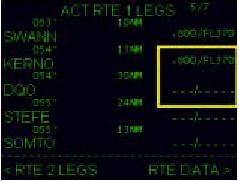
Looking further down the route toward the destination, the altitude predictions have ended.
行き先に向かってルートを下がって見てください。高度の予想は終了しています
The FMC calculates a “top of descent” (T/D) point where the aircraft would begin an idle power descent to arrive at the bottom of the descent (in this case at KLGA).
FMC は飛行機がアイドルパワーにして降下最終地点に到着するための開始地点 "top of descent" ( T/D ) 降下開始地点を計算します
In the absence of altitude restrictions on the legs page, the FMC makes no predictions on waypoint crossing altitudes.
LEGS ページに制限高度が無いので、FMC はウェイポイントの通過時点の高度の予想をしません
In our example, the FMC has calculated that a descent must begin just after passing the KERNO waypoint in order to arrive over KLGA at field elevation.
ここでの例では、FMC により KLGA 到着の KERNO ウェイポイントを通過した直後に降下を始めなければならないと計算されています
It is rare that a flight will fly to a destination and then make an idle power descent to landing.
まれにフライトが目的地に飛行して、そのあとアイドルパワーで降下して着陸します
Therefore, altitude restrictions are usually given on an arrival procedure and subsequently entered into the LEGS page.
ゆえに、高度制限はアライバルプロシージャーにはたいてい与えられており、LEGS ページに入力されます
The MINKS1 into KLGA calls for two altitude crossing restrictions.
KLGA の MINKS1 は 2 つの通過点高度制限があります
The first one is to cross KERNO at FL260 and the second is to cross SOMTO at 13000.
最初の 1 つは KERNO 通過の時で FL260 です。2 つ目は SOMTO の通過の時で 13000 フィートです
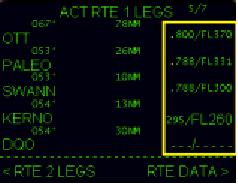
Let’s consider the KERNO crossing restriction first.
KERNO 通過制限高度について最初に考えてみましょう
To enter the crossing restriction on the LEGS page, type “26000” into the scratchpad and then press the right side LSK abeam KERNO.
LEGS ページでの通過制限の入力は、スクラッチパッドに "26000" と入力し、KERNO の真横の右側の LSK を押します
The resulting display is shown at right (note: the legs order has been modified for explanation purposes).
その結果表示は右の絵のようになります ( ノート:LEGS のオーダーは目的の説明のために修正されています )
The entry of this altitude restriction at KERNO has caused the FMC to calculate a new top of descent point where the aircraft should begin an idle power descent to cross KERNO at FL260.
この KERNO での高度制限の入力により、FMC は飛行機がアイドルパワーで降下して KERNO を FL260 で通過するための新しい降下開始地点を計算します
The T/D occurs just after the OTT waypoint and would be displayed on the EHSI as a green circle labeled “T/D” along the route.
T/D は OTT ウェイポイントの直後にあり、EHSI 上でルート上にグリーンの丸で "T/D" と表示されます
All waypoints leading up to KERNO have altitude predictions based on the calculated idle descent path.
KERNO に導かれる全てのウェイポイントはアイドルディセントパスの計算を元にした高度が予想されます

Now lets enter the next altitude restriction at the SOMTO waypoint.
次の SAMTO ウェイポイントの高度制限を入力しましょう
Type “13000” into the scratchpad and press the right side LSK abeam the SOMTO waypoint.
スクラッチパッドに "13000" と入力し、SOMTO ウェイポイントの真横の右側の LSK を押します
The resulting display is shown at right (note: again modified for display purposes).
その結果表示は右の絵のようになります ( ノート:表示の目的のため再度修正しています )
The FMC has now calculated a direct descent path from KERNO to SOMTO.
FMC は KERNO から SOMTO へのダイレクトディセントパスを計算します
The waypoints in between have predicted crossing altitudes listed.
この間のウェイポイントは予想通過高度がリスト表示されます
After SOMTO, there are no predictions listed because no other altitude restrictions exist.
SOMTO のあとは予想の表示はありません。なぜなら他に高度制限が存在しないからです
Altitudes programmed into the LEGS page as we have demonstrated are “hard” altitudes.
LEGS ページでプログラムされている高度は、デモでは "hard" 高度になっています
This means that the FMC treats these manually entered altitudes as crossing “restrictions”.
この意味は FMC はこれらのマニュアルで入力した高度の "restrictions" 制限で通過します
When in VNAV, the AFDS plans to cross each waypoint that has a manual restriction at the programmed altitude.
VNAV の時、AFDS はそれぞれのウェイポイントの通過をマニュアルで制限された高度をプログラムして計画します
The predicted altitudes (small font) are not hard altitudes and are considered advisories.
予想高度 ( 小さい文字 ) はハード高度ではなく、良く考えてみましょう
There are 3 other valid LEGS page altitude entries.
LEGS ページに入力する高度には 3 種類在ります
1. Cross at or above an altitude: To specify that VNAV should cross a waypoint at or above an altitude, place an “A” after the altitude entry prior to insertion into the LEGS page.
指定高度以上を通過:VNAV にウェイポイントを指定高度以上で通過するよう指定します。LEGS ページへの挿入の前に高度入力の後ろに "A" を付けます
For example, to tell VNAV to cross at or above SOMTO at 13000 in the above example, we place “13000A” into the data block.
たとえば VNAV で SOMTO を 13000 フィート以上の高度で通過するには上の例のようにデータブロックに "13000A" と入れます
2. Cross at or below an altitude: To specify that VNAV should cross a waypoint at or below an altitude, place a “B” after the altitude entry prior to insertion into the LEGS page.
指定高度以下を通過:VNAV にウェイポイントを指定高度以下で通過するよう指定します。LEGS ページへの挿入の前に高度入力の後に "B" を付けます
For example, to tell VNAV to cross at or below KERNO at 26000 in the above example, we place “26000B” into the data block.
たとえば VNAV で KERNO を 26000 フィート以下の高度で通過するには上の例のようにデータブロックに "26000B" と入れます
3. Cross at or below and at or above an altitude: This is a double restriction for VNAV to cross a waypoint at or below a certain altitude but to also cross at or above another altitude.
以下と以上の高度で通過:これは 2 銃の高度制限がある場合です。VNAV はウェイポイントを指定高度以下で通過します。しかしこれはもうひとつの指定高度以上での通過でもあります
To do this, enter the altitude to cross below with a B followed by the altitude to cross above with an A.
これをするには、B で以下の通過高度の後に続けて A で以上の通過高度を入力します
For example, to tell VNAV to cross at or below 27000 feet but at or above 26000 feet at KERNO, type in “27000B26000A” into the corresponding data block.
例えば、VNAV が KERNO を 27000 フィート以下で、しかしまた 26000 フィート以上で通過する時は、相当するデータブロックに "27000B26000A" と入力します
In the above examples, we have shown how to place altitude-crossing restrictions into the LEGS page for descent.
上の例で、降下のための LEGS ページでの通過高度の制限方法について見てきました
However, it is also possible to place altitude-crossing restrictions into the LEGS page for the climb as well.
しかしながら、それは上昇についての LEGS ページの通過高度制限の入力にも可能です
Any altitude placed into the LEGS page prior to the calculated T/C is treated as an altitude climb restriction.
T/C 計算の前に LEGS ページへの高度は、上昇の制限高度も扱われます
This will be demonstrated later in this chapter.
これはこの章の後でデモします